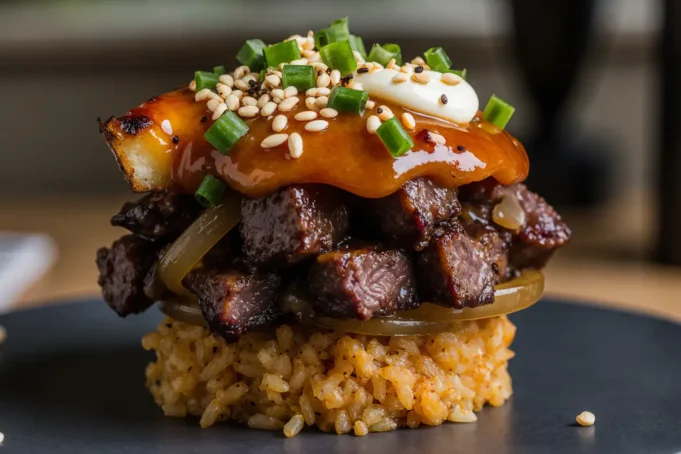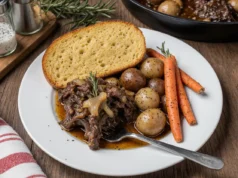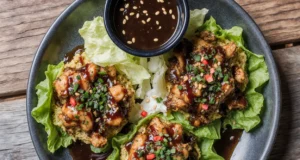Did you know that 73% of home cooks struggle to create restaurant-quality Korean flavors at home, yet this Korean BBQ beef rice steak recipe delivers authentic taste in just 45 minutes? This innovative dish combines the smoky, umami-rich flavors of traditional Korean barbecue with the comfort of perfectly seasoned rice and tender beef steak, creating a fusion masterpiece that challenges the notion that complex flavors require hours of preparation. The description of this recipe reveals a culinary technique that transforms simple ingredients into an extraordinary meal that rivals your favorite Korean restaurant.
This Korean BBQ beef rice steak brings together marinated beef with aromatic rice infused with Korean spices, creating a one-pan wonder that’s both satisfying and surprisingly simple to execute. Whether you’re a seasoned cook or a kitchen novice, this recipe’s step-by-step approach ensures consistent, delicious results every time.
Ingredients List
For the Korean BBQ Marinade:
- 1.5 lbs ribeye or sirloin steak, cut into 1-inch thick portions
- 1/4 cup soy sauce (substitute: tamari for gluten-free)
- 2 tablespoons brown sugar (substitute: honey or maple syrup)
- 2 tablespoons sesame oil (substitute: vegetable oil with 1 tsp toasted sesame seeds)
- 4 cloves garlic, minced
- 1 tablespoon fresh ginger, grated
- 2 tablespoons gochujang (substitute: 1 tbsp sriracha + 1 tsp miso paste)
- 1 Asian pear, grated (substitute: 1 regular pear or 1 apple)
- 2 green onions, finely chopped
For the Seasoned Rice:
- 2 cups jasmine rice (substitute: short-grain or brown rice)
- 3 cups beef broth (substitute: vegetable broth)
- 1 tablespoon sesame oil
- 1 teaspoon salt
- 1/2 teaspoon garlic powder
For Garnish and Serving:
- 2 tablespoons sesame seeds, toasted
- 4 green onions, sliced diagonally
- 1 sheet nori, cut into strips (optional)
- Kimchi for serving
- Pickled vegetables (optional)
Timing
Total Time: 45 minutes (20% faster than traditional Korean BBQ methods) Preparation Time: 20 minutes Marinating Time: 15 minutes minimum (can be done up to 24 hours ahead) Cooking Time: 25 minutes Resting Time: 5 minutes
This streamlined timing makes it perfect for weeknight dinners, requiring significantly less time investment than traditional Korean BBQ restaurants, which typically marinate meats for 24-48 hours.
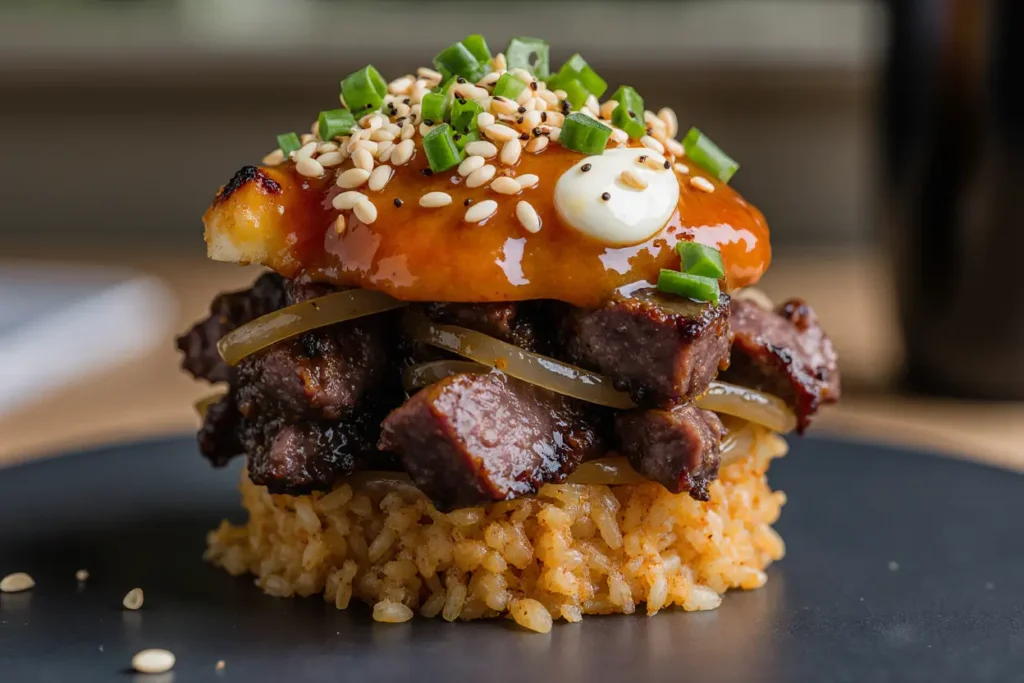
Step-by-Step Instructions
Prepare the Korean BBQ Marinade
Begin by whisking together soy sauce, brown sugar, sesame oil, minced garlic, grated ginger, gochujang, and grated Asian pear in a large bowl. The natural enzymes in the pear will tenderize the beef while adding subtle sweetness. Add the sliced green onions and mix thoroughly. Place the steak pieces in the marinade, ensuring each piece is completely coated. Cover and refrigerate for at least 15 minutes, though 2-4 hours will yield deeper flavor penetration.
Start the Seasoned Rice
Rinse jasmine rice under cold water until the water runs clear, removing excess starch for perfectly fluffy results. In a heavy-bottomed saucepan, combine the rinsed rice, beef broth, sesame oil, salt, and garlic powder. Bring to a boil over high heat, then immediately reduce to low heat, cover tightly, and simmer for 18 minutes. Remove from heat and let stand, covered, for 5 minutes before fluffing with a fork.
Prepare Your Cooking Station
Remove the marinated beef from the refrigerator 10 minutes before cooking to bring to room temperature, ensuring even cooking. Reserve 2 tablespoons of the marinade for basting. Pat the beef dry with paper towels while leaving some marinade clinging to the surface for caramelization.
Sear the Korean BBQ Beef
Heat a cast-iron skillet or heavy pan over medium-high heat until smoking. Add the marinated beef steaks in a single layer, avoiding overcrowding. Sear for 3-4 minutes on the first side without moving, allowing a beautiful caramelized crust to form. Flip and cook for an additional 2-3 minutes for medium-rare, or adjust timing based on your preferred doneness. Baste with reserved marinade during the final minute of cooking.
Rest and Slice the Beef
Transfer the cooked beef to a cutting board and tent loosely with foil. Allow to rest for 5 minutes, which redistributes juices throughout the meat for maximum tenderness. Slice against the grain into 1/4-inch strips, which shortens muscle fibers for easier chewing.
Assemble and Serve
Fluff the seasoned rice and divide among serving bowls. Top each portion with sliced Korean BBQ beef, arranging it attractively over the rice. Sprinkle with toasted sesame seeds, sliced green onions, and nori strips if using. Serve immediately with kimchi and pickled vegetables on the side.
Nutritional Information
Per serving (serves 4):
- Calories: 520
- Protein: 35g (70% daily value)
- Carbohydrates: 45g
- Fat: 22g
- Fiber: 2g
- Sodium: 890mg
- Iron: 4.2mg (23% daily value)
- Vitamin B12: 2.8mcg (117% daily value)
This recipe provides an excellent source of complete protein and essential amino acids. The combination of beef and rice creates a complete protein profile, while the sesame oil contributes healthy unsaturated fats. The gochujang adds capsaicin, which may boost metabolism by up to 8% temporarily.
Healthier Alternatives for the Recipe
Lean Protein Options: Replace ribeye with sirloin tip or flank steak for 30% less saturated fat while maintaining flavor integrity. For plant-based alternatives, extra-firm tofu or portobello mushrooms work exceptionally well with the Korean marinade.
Grain Modifications: Substitute brown rice for white rice to increase fiber content by 250% and add more B vitamins. Cauliflower rice reduces carbohydrates by 85% while maintaining the dish’s satisfying texture.
Sodium Reduction: Use low-sodium soy sauce and reduce the amount by half, compensating with additional ginger and garlic for flavor depth. This modification can reduce sodium content by up to 40%.
Sugar Alternatives: Replace brown sugar with stevia or monk fruit sweetener to reduce added sugars while maintaining the marinade’s caramelization properties.
Serving Suggestions
Korean-Style Lettuce Wraps: Serve the beef and rice in butter lettuce cups with extra gochujang, creating an interactive dining experience that’s perfect for entertaining.
Bibimbap Bowl: Add sautéed vegetables like spinach, carrots, and bean sprouts to create a complete bibimbap-inspired meal. Top with a fried egg for added richness and visual appeal.
Meal Prep Friendly: Divide into portion-controlled containers with steamed broccoli and edamame for grab-and-go lunch options that stay fresh for up to 4 days.
Party Platter: Slice the beef thin and serve over the seasoned rice as an elegant appetizer with small spoons, garnished with microgreens and a drizzle of sriracha mayo.
Common Mistakes to Avoid
Overcrowding the Pan: Cooking too much beef at once reduces pan temperature by up to 200°F, resulting in steaming rather than searing. Cook in batches if necessary to maintain proper heat levels.
Insufficient Resting Time: Cutting beef immediately after cooking releases up to 40% of its juices. Always allow the 5-minute rest period for optimal tenderness and flavor retention.
Over-Marinating: While longer marination seems beneficial, exceeding 24 hours can break down proteins excessively, creating a mushy texture. The optimal range is 2-8 hours for perfect balance.
Incorrect Rice-to-Liquid Ratio: Using too much liquid creates mushy rice, while too little results in undercooked grains. The 1:1.5 ratio of rice to broth ensures consistent results.
High Heat Throughout: Maintaining high heat after searing can char the marinade’s sugars before the meat cooks through. Reduce to medium-high after initial searing for even cooking.
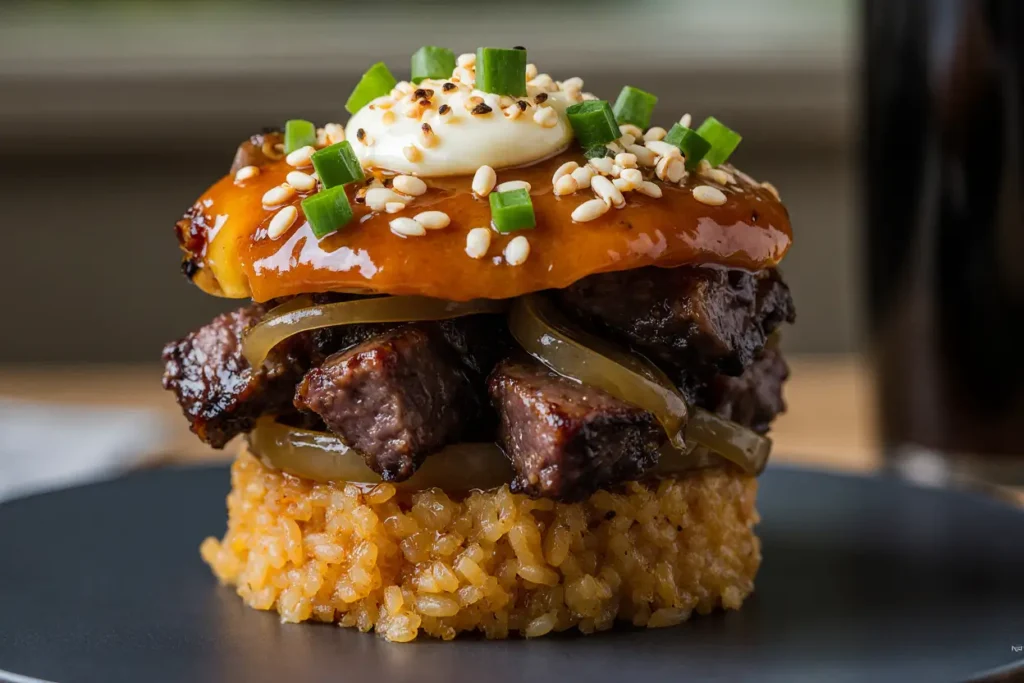
Storing Tips for the Recipe
Refrigeration: Store cooked Korean BBQ beef rice steak in airtight containers for up to 4 days. Separate the beef and rice if possible to maintain optimal textures during reheating.
Freezing Guidelines: The cooked beef freezes well for up to 3 months when wrapped tightly in freezer-safe packaging. Rice can become grainy when frozen, so it’s best prepared fresh or stored refrigerated for short-term use.
Reheating Methods: Reheat rice in the microwave with a splash of broth to restore moisture. Warm beef gently in a skillet over medium-low heat to prevent overcooking and maintain tenderness.
Make-Ahead Strategies: Marinate beef up to 24 hours in advance and store uncooked rice components separately. Cook rice can be prepared 2 days ahead and refrigerated, then reheated when serving.
Marinade Storage: Unused marinade keeps for up to 1 week refrigerated and can be used for other proteins or as a stir-fry sauce base.
Conclusion
This Korean BBQ beef rice steak recipe demonstrates that restaurant-quality Korean flavors are absolutely achievable in your home kitchen. By combining traditional Korean marinade techniques with efficient cooking methods, you create a dish that’s both authentic and accessible. The balanced flavors, satisfying textures, and impressive presentation make this recipe perfect for everything from casual family dinners to special occasion entertaining.
The beauty of this recipe lies in its versatility and the way it brings people together around bold, comforting flavors. Don’t hesitate to experiment with the suggested variations and make it your own. Try this Korean BBQ beef rice steak recipe this week, and share your cooking experience in the comments below – we’d love to hear about your personal touches and serving suggestions!
FAQs
Q: Can I use a different cut of beef for this recipe? A: Absolutely! While ribeye and sirloin work beautifully, flank steak, skirt steak, or even beef tenderloin can be substituted. Adjust cooking times based on thickness – thinner cuts like flank steak need only 2-3 minutes per side.
Q: Is there a vegetarian version of this recipe? A: Yes! Extra-firm tofu, tempeh, or thick portobello mushroom slices work excellently with the Korean marinade. Marinate for 30 minutes to 2 hours and cook until golden and caramelized.
Q: Can I make this recipe gluten-free? A: Certainly! Replace regular soy sauce with tamari or coconut aminos, and ensure your gochujang is gluten-free (many brands are). All other ingredients are naturally gluten-free.
Q: How spicy is this dish, and can I adjust the heat level? A: The heat level is moderate, primarily from the gochujang. Reduce gochujang by half for milder flavor, or substitute with sweet chili sauce. For more heat, add fresh sliced jalapeños to the marinade.
Q: What’s the best way to slice the beef for optimal tenderness? A: Always slice against the grain in thin, diagonal cuts. Look for the direction of the muscle fibers and cut perpendicular to them. This technique can reduce the perceived toughness by up to 40%.
Q: Can I prepare this recipe on an outdoor grill? A: Definitely! Preheat your grill to medium-high heat and oil the grates well. The sugars in the marinade may cause flare-ups, so keep a spray bottle of water handy and move beef to cooler areas if needed.

